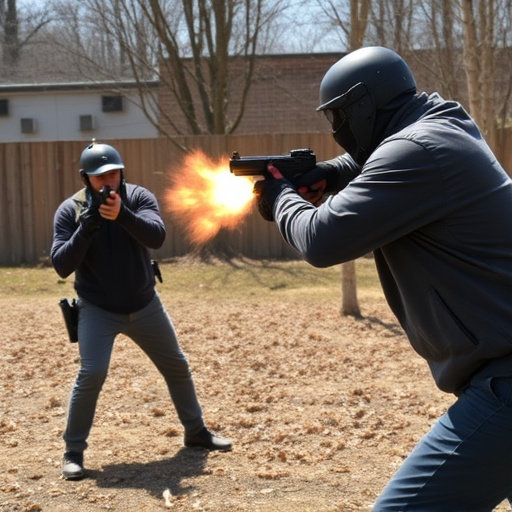Compact Stun Guns: Size, Design, and Neurological Impact
Stun guns, or electronic control devices (ECDs), use electrical pulses to temporarily disable target…….
Stun guns, or electronic control devices (ECDs), use electrical pulses to temporarily disable targets by affecting muscular control and orientation. While effective for personal defense, they carry neurological side effects like pain, disorientation, and muscle weakness. Modern engineering has enabled significant size reductions in stun guns without compromising power or functionality, allowing users to defend themselves discreetly while maintaining ease of carry. Precise electrode design, strategic miniaturization of components, and enhanced precision engineering ensure compact stun guns deliver shock effectiveness while remaining powerful and easily concealable.
In an era where personal safety is paramount, compact stun guns have emerged as a popular self-defense option. This article delves into the intricate world of stun gun design, focusing on their compact size specifications. We explore the balance between power, weight, and battery life, while examining the technical considerations that ensure durability and impact resistance. Furthermore, we investigate the neurological side effects associated with stun guns, particularly in the context of compact designs, shedding light on the critical interplay between effectiveness and safety.
- Understanding Stun Gun Design and Compactness
- – Definition of stun guns and their purpose
- – Key components and how they contribute to size considerations
Understanding Stun Gun Design and Compactness

Stun guns, also known as electronic control devices (ECDs), are designed to immobilize a target through electrical impulsification, causing temporary disorientation and muscular control loss. Understanding their design is crucial when evaluating compactness, especially as the demand for smaller, more discreet self-defense tools grows. The core component of a stun gun is its circuit board, which generates high-voltage, low-current electrical pulses that target the nervous system, specifically the muscles and brain. This technology, while effective against assailants, comes with neurological side effects, making compact design an even more critical factor for personal safety.
Compact stun guns aim to balance power, effectiveness, and discreteness. Smaller devices often sacrifice some power output, but modern engineering has enabled significant reductions in size without compromising functionality. These miniaturized stun guns maintain the essential components required to deliver a powerful shock, ensuring users can defend themselves effectively in various situations. The pursuit of compactness also considers ease of carry, allowing individuals to have a reliable self-defense tool readily available.
– Definition of stun guns and their purpose

Stun guns, also known as electronic control devices (ECDs), are non-lethal weapons designed to temporarily incapacitate a target through electrical disruption. They emit a powerful electric current that overloads the nervous system, causing muscle spasms and disorientation. This brief but intense response allows users to gain time and distance from potential threats. The primary purpose of stun guns is to provide personal defense for individuals facing dangerous situations, offering an alternative to firearms in certain contexts.
While stun guns are generally considered safer than traditional weapons due to their non-lethal nature, it’s crucial to understand the potential neurological side effects associated with their use. Short-term impacts may include pain, disorientation, and muscle weakness. Prolonged or repeated exposure to stun gun shocks could lead to more severe neurological consequences, although these cases are rare. Understanding these risks is essential for responsible usage and ensuring the safety of both users and bystanders.
– Key components and how they contribute to size considerations

When designing a compact stun gun, key components and their size play a crucial role in overall dimensions. The stun gun’s power source, typically a rechargeable battery, must be compact yet able to deliver sufficient energy for effective shock. Advanced circuitry and control modules, responsible for managing voltage output and safety features, contribute significantly to the device’s footprint. These components are strategically miniaturized to fit within the stun gun’s reduced size, ensuring it remains portable without compromising performance.
Another critical aspect is the electrode design and placement. Electrodes deliver the electrical current that causes neurological side effects in targets, temporarily paralyzing them. Compact stun guns often feature smaller electrodes, requiring enhanced precision engineering to maintain effectiveness while minimizing overall size. This delicate balance ensures users have a powerful yet easily concealed self-defense tool, with considerations for both performance and portability.
When considering a compact stun gun, understanding its design and key components is crucial. These devices are designed to deliver a powerful electric shock with minimal physical dimensions, making them easily portable. While size does not directly correlate with effectiveness, it influences accessibility and convenience for self-defense. Remember that the primary purpose of a stun gun is to cause temporary neurological side effects, like muscle paralysis, to disable an attacker, allowing users to escape safely. As you explore options, weigh compactness against power output and personal safety needs.


